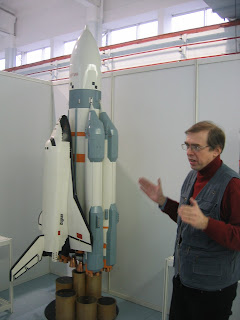Energia is the home of the former Soviet space program. It was by far one of the best excursions that our program has arranged. Our tour guide spoke excellent English and was extremely knowledgeable. During our tour, we saw things like a duplicate of Sputnik, Yuri Gagarin's original re-entry capsule, a life-size model of the Mir Space Station, and a couple cosmonaut toilets, too. Today, the remaining engineers at Energia work on commercial satellite-launching ventures.

Sergei Korolev, father of the Russian space program (and the space race)

Yuri Gagarin, the first man in space

A contemporary copy of the original Sputnik, which means "traveling companion" or "satellite" in Russian

Me standing next to a huge camera that was launched into space in order to take a picture of the dark side of the moon

These are all models of the first stuff that was launched into space: batteries, solar panels, cameras, and those sorts of things

Another model of space-junk; I can't believe this stuff worked

In the foreground you can see an early model cosmonaut toilet

And here is a later model space toilet, found on the Mir Space Station

The first re-entry capsule was designed for laboratory animals

The next re-entry capsule was designed for Yuri Gagarin; this is the real deal

This gadget is the coolest piece of technology that our guide showed us. It is a
gyroscopic stabilizer that was used on the Mir Space Station as a joint between the gigantic modules that comprised the station. The stability that the central axis of the gyroscope supplies when a torque is applied to the gyroscopic frame allows the modules to be rotated with a small amount of energy, which is at a premium in space. Our guide said that each kilogram put into space costs twenty-thousand dollars, so that it's best to conserve on heavy batteries and large motors with gizmos like this.

And lastly, a cosmonaut suit, which comes in one piece; cosmonauts step into the suit from a hatch in the back
 Sergei Korolev, father of the Russian space program (and the space race)
Sergei Korolev, father of the Russian space program (and the space race) Yuri Gagarin, the first man in space
Yuri Gagarin, the first man in space A contemporary copy of the original Sputnik, which means "traveling companion" or "satellite" in Russian
A contemporary copy of the original Sputnik, which means "traveling companion" or "satellite" in Russian Me standing next to a huge camera that was launched into space in order to take a picture of the dark side of the moon
Me standing next to a huge camera that was launched into space in order to take a picture of the dark side of the moon These are all models of the first stuff that was launched into space: batteries, solar panels, cameras, and those sorts of things
These are all models of the first stuff that was launched into space: batteries, solar panels, cameras, and those sorts of things Another model of space-junk; I can't believe this stuff worked
Another model of space-junk; I can't believe this stuff worked In the foreground you can see an early model cosmonaut toilet
In the foreground you can see an early model cosmonaut toilet And here is a later model space toilet, found on the Mir Space Station
And here is a later model space toilet, found on the Mir Space Station The first re-entry capsule was designed for laboratory animals
The first re-entry capsule was designed for laboratory animals The next re-entry capsule was designed for Yuri Gagarin; this is the real deal
The next re-entry capsule was designed for Yuri Gagarin; this is the real deal This gadget is the coolest piece of technology that our guide showed us. It is a gyroscopic stabilizer that was used on the Mir Space Station as a joint between the gigantic modules that comprised the station. The stability that the central axis of the gyroscope supplies when a torque is applied to the gyroscopic frame allows the modules to be rotated with a small amount of energy, which is at a premium in space. Our guide said that each kilogram put into space costs twenty-thousand dollars, so that it's best to conserve on heavy batteries and large motors with gizmos like this.
This gadget is the coolest piece of technology that our guide showed us. It is a gyroscopic stabilizer that was used on the Mir Space Station as a joint between the gigantic modules that comprised the station. The stability that the central axis of the gyroscope supplies when a torque is applied to the gyroscopic frame allows the modules to be rotated with a small amount of energy, which is at a premium in space. Our guide said that each kilogram put into space costs twenty-thousand dollars, so that it's best to conserve on heavy batteries and large motors with gizmos like this. And lastly, a cosmonaut suit, which comes in one piece; cosmonauts step into the suit from a hatch in the back
And lastly, a cosmonaut suit, which comes in one piece; cosmonauts step into the suit from a hatch in the back


